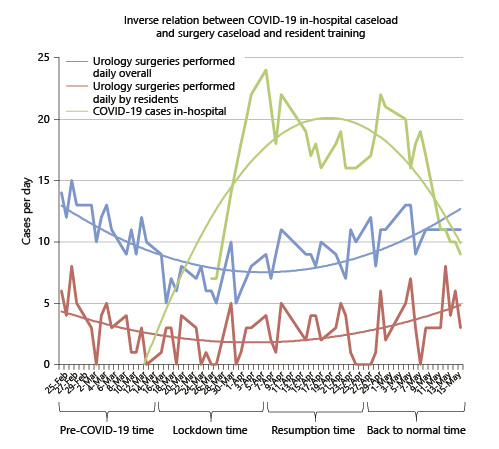Dear Editor,
The coronavirus disease 2019 (COVID-19) pandemic is disrupting urology healthcare worldwide [1]. Constraints on healthcare resources have led to prioritization strategies aiming to minimize patient harm during a time of reduced surgical caseload capacity [2]. In phase 2 of the pandemic, we experienced in our department decreasing COVID-19 in-hospital caseload over time, allowing for increasing surgical caseload for urology consultants and residents. Here, we aimed to investigate the course of urological surgical caseload in our department before and during the COVID-19 pandemic and its relationship to local COVID-19 infection load.
We performed a retrospective analysis of all scheduled urology surgeries under general anaesthesia performed in our department during a time frame of 12 weeks between February 25, 2020, and May 15, 2020. To track the overall surgical caseload, we recorded the number of surgeries performed overall in the urology department. To track the surgical training of urology residents, we recorded the number of surgeries performed by urology residents. Simultaneously, the number of COVID-19-positive tested in-hospital patients was recorded. The 12-week time span was divided into 4 time periods of each successive 3 weeks: pre-COVID-19 time, lockdown time, resumption time, and back-to-normal time. Low prioritization pressure leads to cancellations of surgeries with low priority according to the 4-tired surgery prioritization list by the German Society of Urology at the beginning of the lockdown time [3], while all oncological cases could be continued irrespective of cancer entity or risk. At the beginning of the resumption time, stone surgery was resumed. At the beginning of the back-to-normal time, all surgeries were resumed.
During 56 working days, we performed 537 surgeries under general anaesthesia, of which 162 (30%) were performed by urology residents. The median number of surgeries per day was 10 overall and 3 for urology residents. In-hospital COVID-19 caseload increased until a peak of 24 cases, remained stable, and decreased thereafter (median: 17.5; range: 7–24 cases). Overall and residents’ surgical caseload, respectively, was 164 and 47 in the pre-COVID-19 time, decreased to 103 and 27 in the lockdown time, increased to 117 and 37 in the resumption time, and increased again to 153 and 51 in the back-to-normal time. One COVID-19 infection occurred in in-hospital urology patients during the 12-week time frame (0.2%). Figure 1 shows an inverse relation between the COVID-19 in-hospital caseload and the urological surgical caseload for both overall number of surgeries and surgeries performed by residents. Ramping up of surgical training for residents is particularly important since slowdown of learning and psychological impacts have been reported [4, 5].
Our single-institution data show that urological surgical caseload and resident training can be ramped up with decreasing COVID-19 infections, aiming to ensure perpetuation of adequate treatment for both oncological and non-oncological urology patients. Limitations include the retrospective study design and lack of data on patient-related outcomes. However, our data show that the burden of surgical caseload deferred due to COVID-19 can be worked off as COVID-19 infections decrease, aiming to minimize the collateral damage of morbimortality in urology patients [6].
Conflict of Interest Statement
The authors have no potential conflict of interest.
Funding Sources
The authors did not receive any funding.
Author Contributions
Project development: H.B. and A.H. Data collection/management: all authors. Data analysis: H.B. Manuscript writing/editing: all authors.



